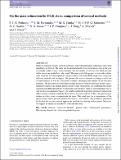Files in this item
On the mass estimation for FGK stars : comparison of several methods
Item metadata
| dc.contributor.author | Pinheiro, F.~J.~G. | |
| dc.contributor.author | Fernandes, J.~M. | |
| dc.contributor.author | Cunha, M.~S. | |
| dc.contributor.author | Monteiro, M.~J.~P.~F.~G. | |
| dc.contributor.author | Santos, N.~C. | |
| dc.contributor.author | Sousa, S.~G. | |
| dc.contributor.author | Marques, J.~P. | |
| dc.contributor.author | Fang, J.-J. | |
| dc.contributor.author | Mortier, A. | |
| dc.contributor.author | Sousa, J. | |
| dc.date.accessioned | 2015-01-15T17:31:02Z | |
| dc.date.available | 2015-01-15T17:31:02Z | |
| dc.date.issued | 2014-12-11 | |
| dc.identifier | 161943763 | |
| dc.identifier | 88d79286-04a9-4866-b54c-33a03b1a46a6 | |
| dc.identifier | 000346962900005 | |
| dc.identifier | 84924533767 | |
| dc.identifier.citation | Pinheiro , F J G , Fernandes , J M , Cunha , M S , Monteiro , M J P F G , Santos , N C , Sousa , S G , Marques , J P , Fang , J-J , Mortier , A & Sousa , J 2014 , ' On the mass estimation for FGK stars : comparison of several methods ' , Monthly Notices of the Royal Astronomical Society , vol. 445 , no. 3 , pp. 2223-2231 . https://doi.org/10.1093/mnras/stu1812 | en |
| dc.identifier.issn | 0035-8711 | |
| dc.identifier.other | Bibtex: urn:05bcf5f8a4e5269287fffcf0e824e5fd | |
| dc.identifier.uri | https://hdl.handle.net/10023/6012 | |
| dc.description | Support was provided by FCT under project /PTDC/CTE-AST/66181/2006 and the /SFRH/BPD/37491/2007 research grant of FJGP, both co-financed by the European Social Fund. MSC is supported by an Investigador FCT contract funded by FCT/MCTES (Portugal) and POPH/FSE (EC) and by funds from the ERC, under FP7/EC, through the project FP7-SPACE-2012-31284. NCS, SGS, and AM acknowledge the support by the European Research Council/European Community under the FP7 through Starting Grant agreement number 239953. NCS is supported by FCT through the Investigador FCT contract reference IF/00169/2012 and POPH/FSE (EC) by FEDER funding through the programme ‘Programa Operacional de Factores de Competitividade – COMPETE’. | en |
| dc.description.abstract | Stellar evolutionary models simulate well binary stars when individual stellar mass and system metallicity are known. The mass can be derived directly from observations only in the case of multiple stellar systems, mainly binaries. Yet, the number of such stars for which accurate stellar masses are available is rather small. The main goal of this project is to provide realistic mass estimates for a homogeneous sample of about a thousand FGK single stars, using four different methods and techniques. We present the masses inferred according to each one of these methods as well as a final mass estimate consisting in the median of the four mass estimates. The procedures evaluated here include the use of stellar evolutionary models, mass–luminosity relation and surface gravity spectroscopic observations. By combining the results obtained with different methods, we determine the best mass value for each individual star, as well as the associated error budget. Our results confirm the expected consistency between the different mass estimation methods. None the less, for masses above 1.2 M⊙, the spectroscopic surface gravities seem to overestimate the mass. This result may be a consequence of the spectroscopic surface gravities used in this analysis. Nevertheless, this problem is minimized by the fact that we have several approaches available for deriving stellar masses. Moreover, we suggest an empirical procedure to overcome this issue. | |
| dc.format.extent | 9 | |
| dc.format.extent | 1657836 | |
| dc.language.iso | eng | |
| dc.relation.ispartof | Monthly Notices of the Royal Astronomical Society | en |
| dc.subject | Methods: numerical | en |
| dc.subject | Binaries: general | en |
| dc.subject | Stars: fundamental parameters | en |
| dc.subject | Hertzsprung-Russell and colour-magnitude diagrams | en |
| dc.subject | QC Physics | en |
| dc.subject.lcc | QC | en |
| dc.title | On the mass estimation for FGK stars : comparison of several methods | en |
| dc.type | Journal article | en |
| dc.contributor.institution | University of St Andrews. School of Physics and Astronomy | en |
| dc.identifier.doi | https://doi.org/10.1093/mnras/stu1812 | |
| dc.description.status | Peer reviewed | en |
| dc.identifier.url | http://mnras.oxfordjournals.org/content/445/3/2223/suppl/DC1 | en |
This item appears in the following Collection(s)
Items in the St Andrews Research Repository are protected by copyright, with all rights reserved, unless otherwise indicated.

